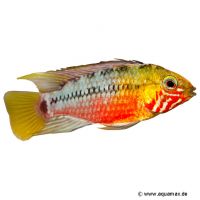Red Streak Cichlid (Apistogramma hongsloi II)
| Red Streak Cichlid Apistogramma hongsloi II | |
|---|---|
| Name | Red Streak Cichlid |
| Name Lat. | Apistogramma hongsloi II |
| Family | Cichlids |
| Family lat. | Cichlidae |
| Order | Cichlids |
| Order lat. | Cichliformes |
| Origin | Colombia |
| Habitat | Streams |
| Diet | Carnivore |
| pH | 5.0-7.0 |
| Behavior | Peaceful |
| Keeping | Pair, harem |
| Care Level | Moderate |
| Reproduction | Cave spawner |
| Breeding | Moderately difficult |
| Life Span | 3-4 years |
| Protection | No |
| Metric Units | |
| Size | ♀ 5 cm, ♂ 7 cm |
| Temperature | 24-29 °C |
| Hardness | 1-10 °dH |
| Aquarium | ~ 150 l |
| US Units | |
| Size | ♀ 2", ♂ 2.8" |
| Temperature | 75-84 °F |
| Hardness | 18-178 ppm |
| Aquarium | ~ 40 gal |
Distribution and habitat
The Hongsloi II dwarf cichlids are a breeding form of the red-lined dwarf cichlids, which occur in the Orinoco tributaries Rio Vichada and Rio Meta as well as in the catchment area of the middle Orinoco in Colombia. They live there in shallow, plant-rich small waters and in the riparian zones of streams and rivers.
Maintenance
The aquarium should have a dense planting, with many hiding places (stones, roots, caves) and offer free swimming space. A dark substrate covered with some foliage (e.g. sea almond leaves) and slightly dim light (floating plants) is ideal.
No ammonia, ammonium and nitrite should be detectable, the nitrate value should not exceed 100 mg/l. To ensure the water quality and oxygen content, a filter and heater adapted to the aquarium size is required, as well as lighting for the species-appropriate day-night rhythm of the animals.
Diet
In the wild they feed mainly on small crustaceans and insect larvae. The food supply consists of live, frozen and dry food. For a balanced diet, feed once a day with a high-quality, protein-rich dry food for cichlids (flakes, granules, pellets) as well as daphnia, artemia, mysis, mosquito larvae, etc. (live or frozen). 
It is recommended to feed small portions several times a day. Only feed as much as will be eaten within a few minutes. A regular and varied diet promotes health and increases resistance.
Behaviour and compatibility
It is recommended to keep them in pairs or in a harem, one male with several females. They are territorial, so keeping several pairs or harems is recommended only in a larger and richly structured tank. They can be kept well with other calm fish, but will consistently defend their territory.
Basically, only compatible fish species with similar demands on water condition and water temperature should be socialized.
Sex dimorphism
The male is larger, more colorful and has much longer, pointed fins. The female is smaller and colored yellow in the spawning season.
Reproduction and breeding
They spawn in caves (cave breeders). The female performs the brood care, while the male defends the territory. After 3-5 days the fry hatch, which are then housed and guarded by the female in a bottom pit until they swim freely after 4-5 days.
Fry must be fed several times a day with special rearing food. Breeding is hardly possible in community tanks, where the fry are easy prey.
Important
They show their most beautiful coloration by feeding on live food.
In addition to different site variants, there are numerous breeding forms with different levels of red.
The foliage (sea almond tree, oak, etc.) enriches the water with humic substances, naturally lowers the pH value and is a valuable secondary food source.
The well-being of the fish should be monitored regularly. Temperature should be checked daily, pH, hardness and nitrate levels at least every 14 days. Regular partial water changes are recommended, even if the contaminant level has not yet reached the upper limit. Sudden changes in water quality should be avoided. Newly introduced fish must be accustomed slowly to the water in the aquarium.
Further literature can be found in your pet store.
References
Text: petdata; Image: www.aquamax.de
Source: BMELV (1998): Tierschutzgutachten - Haltung von Zierfischen (Süßwasser); BAENSCH & RIEHL (2004): Aquarien Atlas Bd. 2, Mergus Verlag; ENGELMANN (2005): Zootierhaltung - Tiere in menschlicher Obhut: Fische, Verlag Harri Deutsch
- Gemäß § 21 Abs. 5 Tierschutzgesetz idgF
